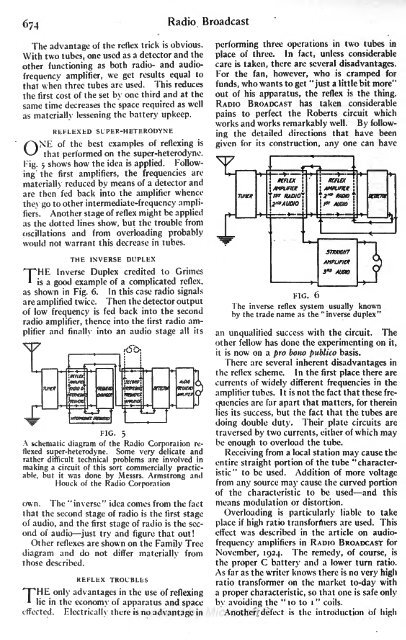Radio Broadcast - 1925, February - 113 Pages ... - VacuumTubeEra
Radio Broadcast - 1925, February - 113 Pages ... - VacuumTubeEra
Radio Broadcast - 1925, February - 113 Pages ... - VacuumTubeEra
You also want an ePaper? Increase the reach of your titles
YUMPU automatically turns print PDFs into web optimized ePapers that Google loves.
674<br />
<strong>Radio</strong><br />
<strong>Broadcast</strong><br />
The advantage of the reflex trick is obvious.<br />
With two tubes, one used as a detector and the<br />
other functioning as both radio- and audiofrequency<br />
amplifier, we get results equal to<br />
that when three tubes are used. This reduces<br />
the first cost of the set by one third and at the<br />
same time decreases the space required as well<br />
as materially lessening the battery upkeep.<br />
REFLEXED SL PER-HETERODYNE<br />
ONE of the best examples of reflexing is<br />
that performed on the super-heterodyne.<br />
Fig. 5<br />
shows how the idea is applied. Following<br />
the first amplifiers, the frequencies are<br />
materially reduced by means of a detector and<br />
are then fed back into the amplifier whence<br />
they go to other intermediate-frequency amplifiers.<br />
Another stage of reflex might be applied<br />
as the dotted lines show, but the trouble from<br />
oscillations and from overloading probably<br />
would not warrant this decrease in tubes.<br />
THE INVERSE DUPLEX<br />
THE Inverse Duplex credited to Grimes<br />
is a good example of a complicated reflex,<br />
as shown in Fig. 6. In this case radio signals<br />
are amplified twice. Then the detector output<br />
of low frequency<br />
is fed back into the second<br />
radio amplifier, thence into the first radio amplifier<br />
and finally into an audio stage<br />
all its
















